The Whiskey Pirates have once again dropped an excellent electronic badge for DEF CON 29. This is, of course, unofficial, but certainly makes the list of the hottest custom bling seen so far this year.
I’m not able to make it to the con in person, but the Pirates sent over one of these badges anyway for an early look. It’s gorgeous, and peering into the circuit board it would be easy to think that the chip shortage ain’t got nothin’ on this badge. But this was possible only because of some very creative parts sourcing, and a huge dose of inspired design work.
The Aesthetic
I usually begin with an overview of the hardware, but come on, this thing looks spectacular! Let’s talk about the aesthetic. This is one of the more polished looks for a hardware badge, akin to the Queercon 15 badge which used PCB faceplate and back, separated by edge-lit acrylic. [TrueControl] sandwiched the PCB between two sheets of acrylic, one that serves as a faceplate with both etched and translucent areas, and a clear backplate that carries the side-firing RGB LEDs to where they can be seen.
At the end of each of the cross-bones there is a black rectangle. At first I thought these were some kind of IR reflectance sensor, but they’re actually button caps. It looks like they’ve been cut out of acrylic of a thickness sized perfectly to be flat with the faceplate. They been superglued to the momentary push switches on the board.
The look of these caps is awesome. The function is a bit rough though, as the throw of the switch is very shallow. I did accidentally pop one of these off, probably by pressing too much on one end. A dab of glue has fixed it right back up.
An OLED display shines through the forehead of the faceplate. The badge acts as a nametag which can be customized from the menu. One of the nice touches is that [TrueControl] once again used his fancy firmware trick that tilts the letters of your name to match the angle of the badge. Pretty slick!
Tearing Down the Hardware
You have to be ambitious to get a good look at the populated board since it’s normally covered by an acrylic plate and the AAA battery holder. After desoldering that and removing the Torx head screws we are left with a really beautifully assembled board.
We find some creative part sourcing at work here. The main chip is a GigaDevices GD32VF103 (PDF datasheet) which is a RISC-V core (not to be confused with the GD32F103 which is an ARM Cortex-M3). [TrueControl] speculates this may be the first unofficial badge project to feature a hardware RISC-V core — the 2019 Hackaday Supercon badge had a RISC-V software core running on an FPGA. Also on board are a PDK13 (one of the Padauk chips — take a look at [Jay Carlson’s] guide we featured a while back) and there’s an 8051-based USB chip (CH552T PDF datasheet) near the bottom of the board for debugging.
There’s a hard power switch to one side. I also find two top-down USB ports next to the battery holder. I tried each of them; one enumerates and powers the badge, the other doesn’t enumerate but it does power the badge. When probing on the serial ports I saw characters echoing back but haven’t explored much beyond that.
The two RGB leds that make up the eyes appear to be flickering and I suspect there’s some data transfer happening there. If you look closely at the circuit board near the button on the bottom right bone, there is a two-pad footprint and a cutout in the faceplate clears the way for it. It’s possible this is some type of light sensor, although It may simply be an IR LED as I would expect a receiver to have three legs.
There’s another trick at play here, which is how to inexpensively source the OLED screens. Looking closely at this one you can see the hack that allows the tails of the pin header to be bridged to some pads on the PCB. These modules are cheap and abundant, but have you ever tried sourcing bare screens and placing your own components to drive them?
Yet Another Superb Offering from the Whiskey Pirates
The most important aspect of making a hardware badge is easily found in this one: passion. Pandemics and chip shortages be damned, [TrueControl] executed on great ideas and got this one over the finish line. The electronic design is quite interesting, and the look achieved reaches a level that everyone will geek out about.
The package arrived with several versions of the face plate. I’m honored that he took the time to etch my name into not one, but three of those plates. And take a look at that part of it — it didn’t end with the etching, those letters are filled with white paint to make them stand out.
If you’re at DEF CON 29 this year, keep an eye out for people wearing these. That’s the Whiskey Pirate crew, and they’re a blast to hang out with. Hopefully I’ll have the chance to do so again at DC30!

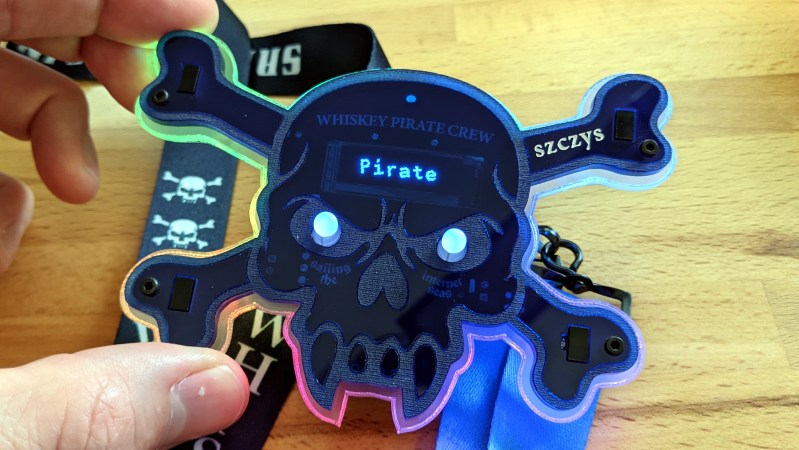
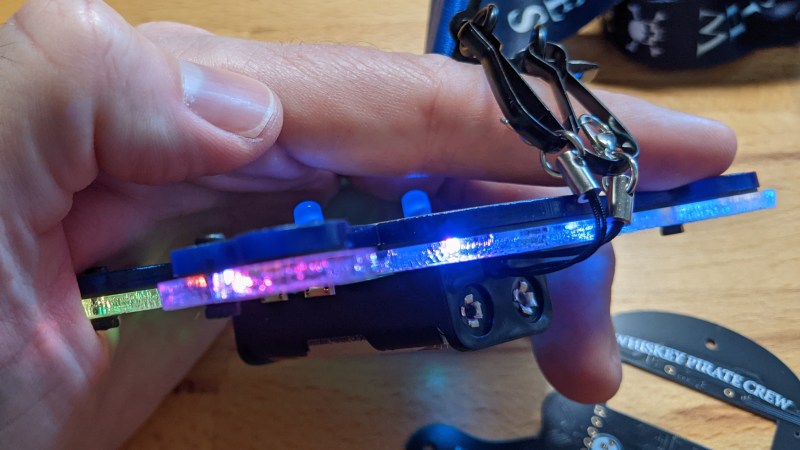
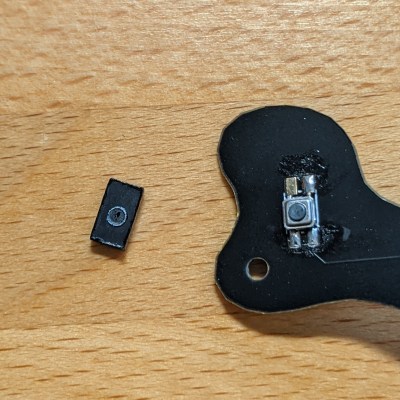
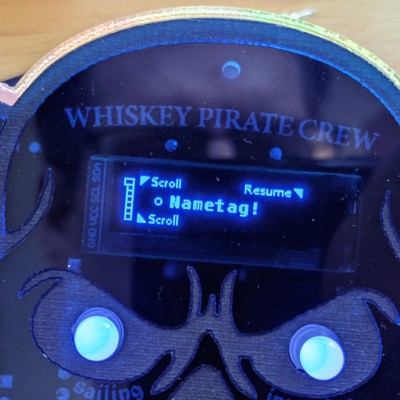
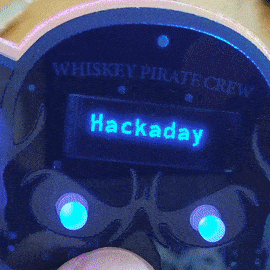

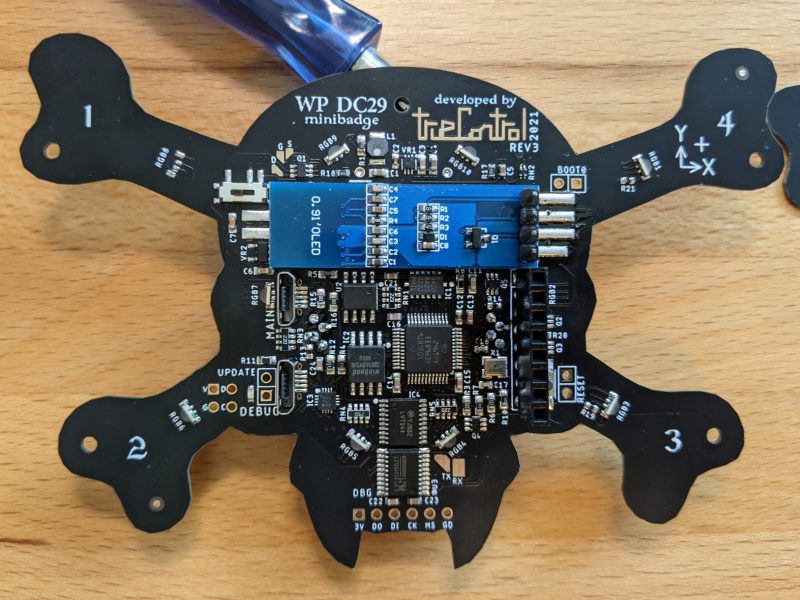



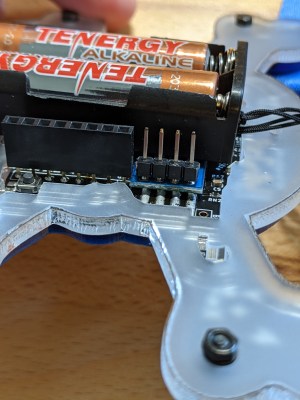
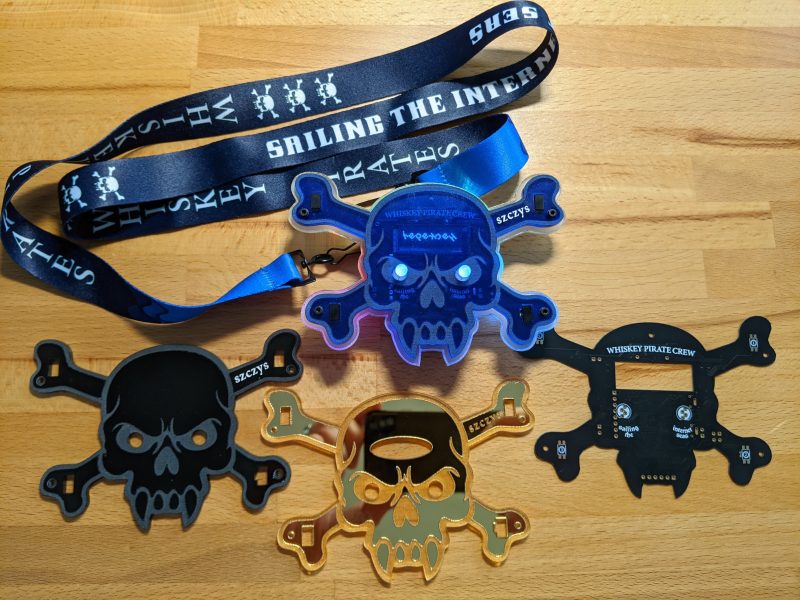













Mike, your GD32VF103 datasheet is somewhere on your local harddisk. No way to access it without running afoul of some laws :-)
Here’s one on the intertubes:
http://www.gd32mcu.com/data/documents/shujushouce/GD32VF103_Datasheet_Rev%201.1.pdf
Whoops, good catch. I’ve updated it now.
Nice to know there are are uC nerds like me that want to jump immediately to the datasheet when a new part number comes down the line ;-)
It’s actually not a “new” part at the speed of this industry. GD32VF103 hit volume in mid 2019 or so. It’s the active ingredient of the Sipeed Longan Nano, the sub $5 board that includes an OLED display. GD32V (as it’s colloquially called) looks like a lot of the STM103 parts, but it replaces the ARM core with a RISC-V core licensed from Nuclei N-200 and includes “real” USB controller so it can be used like a (very tiny) USB disk, for example – booting via DFU is handy. Sipeed and others have a bunch of eval and demo boards for it. The Nano board is about on part with a Blue Pill and I think they recently rolled the board layout to expose a few more GPIOs as a minor imporvement.
It had birthing pains of crummy Chinese doc, but it’s now fully supported by the GNU toolchains and common libraries. Blogs have filled in the holes left by the (now largely translated) doc. PlatformIO and Rust support the core and peripherals. Open source libraries for them are plentiful with tags on github for them. Now that English doc and tool support for thing like libraries and IDEs seems to have migrated from Gigadevices to nucleisys, the quality seems improved. Most of the popular light-weight RTOSes (FreeRTOS, LiteOS, Riot, various thread-switchers) and commercial RISC-V tools (Lauterbach, Seeger) support it.
uC nerds should add this to your collection, for sure. Also up: BL602 and BL706, with Sipeed shipping a sub $4 RISC-V board. (No screen, but much more RAM and ROM + BT).
These badges look awesome!
A few corrections:
– Whiskey Pirates is adamantly not “badgelife.”
– We are seriously ADAMANTLY NOT “badgelife.” Please don’t mix us in with that.
– Button glue is polyurethane. It’s a total hack and makes the buttons fragile. Yay prototypes as final result run.
– Most other technical stuff in the article is correct this time. Other than the guesses =)
Other notes:
– Badges before #50 or so have really rough button action as I was still figuring out glue dry timing and acutation to make them not stick. Most after that work a bit nicer. Still fragile.
– Each badge _is_ serialed; can see serial number in the About menu.
– The top USB port is for the main micro, the bottom for the debugger. The top one doesn’t do anything in the application yet but will enumerate when using the bootloader (short BOOT0 when plugging in). I have plans for use, but as usual, no time
– The eyes “flicker” is because the default program is to “flicker” your favorite color, which can be set in the menu. There is no data transfer. There are several LED programs for the edge and eye LEDs and these LED programs can be customized with the built in hex editor.
– The bottom LED is a red LED used as 1) light sensing and 2) notification of low battery, as indicated on the back acrylic layer.
– The last photo shows the faceplates with the paper intact, and the wrong side of the mirror =(
– The only things made elsewhere are the ICs and the PCB. Everything else was fabricated and assembled at true’s house. Each badge has about 4 hours of labor. This was a rushjob and only started I think the second half of June.
– A photo in a dark room might show what the design aesthetic really is about =)
Thanks for running an article about this. I’m still assembling the last ones as of the second day of DC29 but hoping to finish soon.
oh and RIP one of the rear LEDs :( not sure if it didn’t make the trip or was ripped off during disassembly. Several issues here, from the pad layout (which I could not test in time for final production boards) to issues with my PnP and limitations of ramp rate with my oven. This badge is VERY fragile to work on. Wish I had time to perfect it and make it easier to disassemble.
It’s awfully impressive and well polished looking for a rush job. Think we’re all our own worst critics. Really cool, I’m glad we got to see it!